Information
LHCb-PAPER-2016-026
CERN-EP-2016-184
arXiv:1608.01289 [PDF]
(Submitted on 03 Aug 2016)
Phys. Rev. D94 (2016) 072001
Inspire 1479164
Tools
Abstract
The Dalitz plot analysis technique is used to study the resonant substructures of $B^{-} \to D^{+} \pi^{-} \pi^{-}$ decays in a data sample corresponding to 3.0 ${\rm fb}^{-1}$ of $pp$ collision data recorded by the LHCb experiment during 2011 and 2012. A model-independent analysis of the angular moments demonstrates the presence of resonances with spins 1, 2 and 3 at high $D^{+}\pi^{-}$ mass. The data are fitted with an amplitude model composed of a quasi-model-independent function to describe the $D^{+}\pi^{-}$ S-wave together with virtual contributions from the $D^{*}(2007)^{0}$ and $B^{*0}$ states, and components corresponding to the $D^{*}_{2}(2460)^{0}$, $D^{*}_{1}(2680)^{0}$, $D^{*}_{3}(2760)^{0}$ and $D^{*}_{2}(3000)^{0}$ resonances. The masses and widths of these resonances are determined together with the branching fractions for their production in $B^{-} \to D^{+} \pi^{-} \pi^{-}$ decays. The $D^{+}\pi^{-}$ S-wave has phase motion consistent with that expected due to the presence of the $D^{*}_{0}(2400)^{0}$ state. These results constitute the first observations of the $D^{*}_{3}(2760)^{0}$ and $D^{*}_{2}(3000)^{0}$ resonances.
Figures and captions
|
Results of the fit to the $B$ candidate invariant mass distribution shown with (left) linear and (right) logarithmic $y$-axis scales. Contributions are as described in the legend. |
Fig1a.pdf [31 KiB] HiDef png [263 KiB] Thumbnail [220 KiB] *.C file |
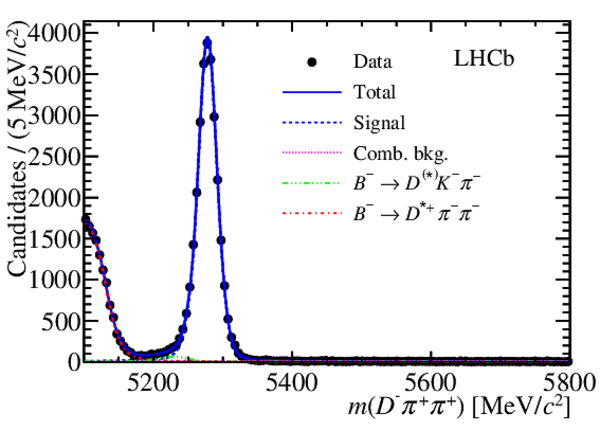
|
|
Fig1b.pdf [31 KiB] HiDef png [299 KiB] Thumbnail [253 KiB] *.C file |

|
|
|
Distribution of $ B ^- \rightarrow D ^+ \pi ^- \pi ^- $ candidates in the signal region over (left) the DP and (right) the SDP. |
Fig2a.pdf [626 KiB] HiDef png [344 KiB] Thumbnail [148 KiB] *.C file |
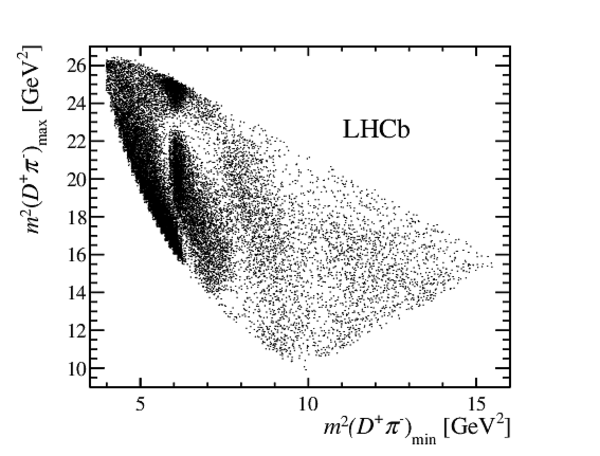
|
|
Fig2b.pdf [342 KiB] HiDef png [524 KiB] Thumbnail [218 KiB] *.C file |

|
|
|
The first seven unnormalised angular moments for background-subtracted and efficiency-corrected data (black points) as a function of $m( D ^+ \pi ^- )$ in the range $2.0$--$4.0\mathrm{ Ge V} $. The blue line shows the result of the DP fit described in Sec. 7. |
Fig3a.pdf [19 KiB] HiDef png [165 KiB] Thumbnail [147 KiB] *.C file |

|
|
Fig3b.pdf [20 KiB] HiDef png [190 KiB] Thumbnail [169 KiB] *.C file |

|
|
|
Fig3c.pdf [19 KiB] HiDef png [168 KiB] Thumbnail [148 KiB] *.C file |
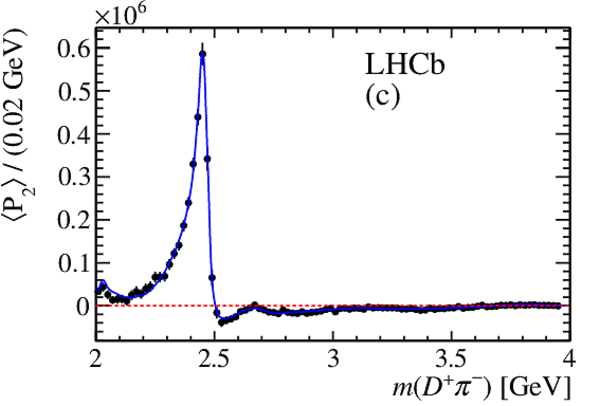
|
|
|
Fig3d.pdf [21 KiB] HiDef png [188 KiB] Thumbnail [172 KiB] *.C file |
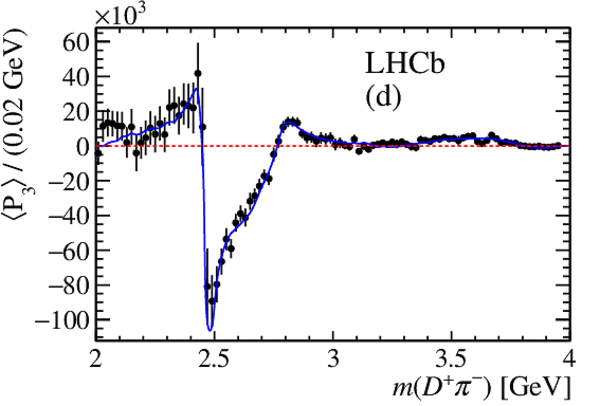
|
|
|
Fig3e.pdf [20 KiB] HiDef png [177 KiB] Thumbnail [162 KiB] *.C file |
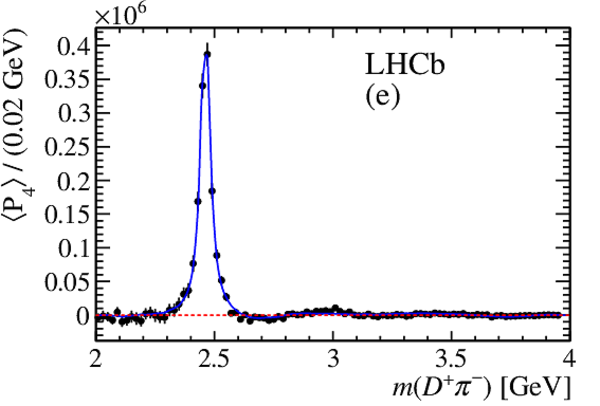
|
|
|
Fig3f.pdf [22 KiB] HiDef png [184 KiB] Thumbnail [178 KiB] *.C file |

|
|
|
Fig3g.pdf [23 KiB] HiDef png [179 KiB] Thumbnail [172 KiB] *.C file |

|
|
|
Unnormalised angular moments $\left\langle P_7 \right\rangle$ and $\left\langle P_8 \right\rangle$ for background-subtracted and efficiency-corrected data (black points) as a function of $m( D ^+ \pi ^- )$ in the range $2.0$--$4.0\mathrm{ Ge V} $. The blue line shows the result of the DP fit described in Sec. 7. |
Fig4a.pdf [24 KiB] HiDef png [187 KiB] Thumbnail [182 KiB] *.C file |

|
|
Fig4b.pdf [25 KiB] HiDef png [182 KiB] Thumbnail [179 KiB] *.C file |

|
|
|
Zoomed views of the fourth and sixth unnormalised angular moments for background-subtracted and efficiency-corrected data (black points) as a function of $m( D ^+ \pi ^- )$. The blue line shows the result of the DP fit described in Sec. 7. |
Fig5a.pdf [17 KiB] HiDef png [162 KiB] Thumbnail [144 KiB] *.C file |

|
|
Fig5b.pdf [19 KiB] HiDef png [168 KiB] Thumbnail [156 KiB] *.C file |
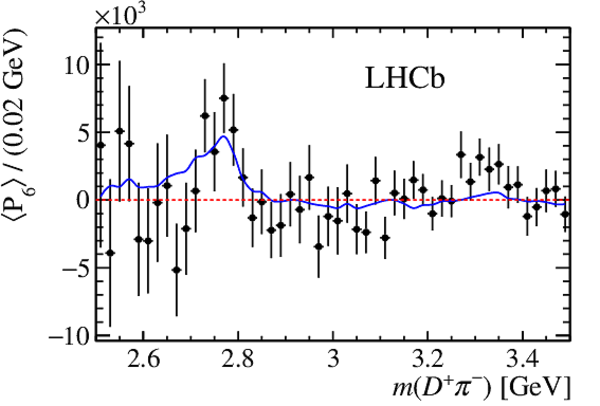
|
|
|
Signal efficiency across the SDP for $ B ^- \rightarrow D ^+ \pi ^- \pi ^- $ decays. The relative uncertainty at each point is typically $5 \%$. |
Fig6.pdf [59 KiB] HiDef png [385 KiB] Thumbnail [348 KiB] *.C file |

|
|
Square Dalitz plot distributions for (left) combinatorial background and (right) $ B ^- \rightarrow D^{(*)+} K ^- \pi ^- $ decays. |
Fig7a.pdf [48 KiB] HiDef png [154 KiB] Thumbnail [138 KiB] *.C file |
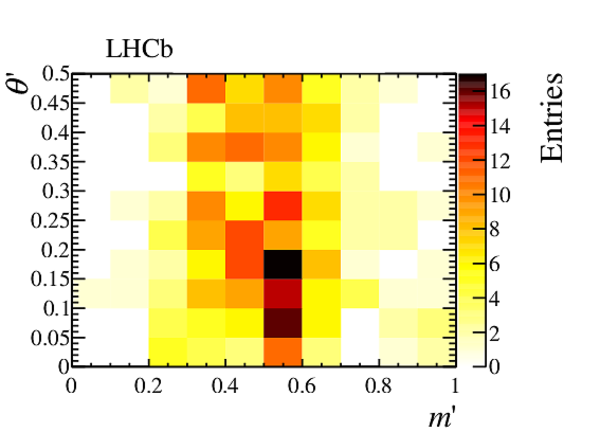
|
|
Fig7b.pdf [50 KiB] HiDef png [159 KiB] Thumbnail [148 KiB] *.C file |

|
|
|
Real and imaginary parts of the S-wave amplitude, shown in an Argand diagram. The knots are shown with statistical uncertainties only, connected by the cubic spline interpolation used in the fit. The leftmost point is that at the lowest value of $m( D ^+ \pi ^- )$, with mass increasing along the connected points. Each point, labelled 1--13, corresponds to the position of a knot in the spline, at values of $m( D ^+ \pi ^- ) = \{ 2.01, 2.10, 2.20, 2.30, 2.40, 2.50, 2.60, 2.70, 2.80, 2.90, 3.10, 4.10, 5.14 \} \mathrm{ Ge V} $. The points at $(0.5,0.0)$ and $(0.0,0.0)$ are fixed. The anticlockwise rotation of the phase at low $m( D ^+ \pi ^- )$ is as expected due to the presence of the $ D ^{*}_{0}(2400)^{0}$ resonance. |
Fig8.pdf [55 KiB] HiDef png [109 KiB] Thumbnail [65 KiB] *.C file |
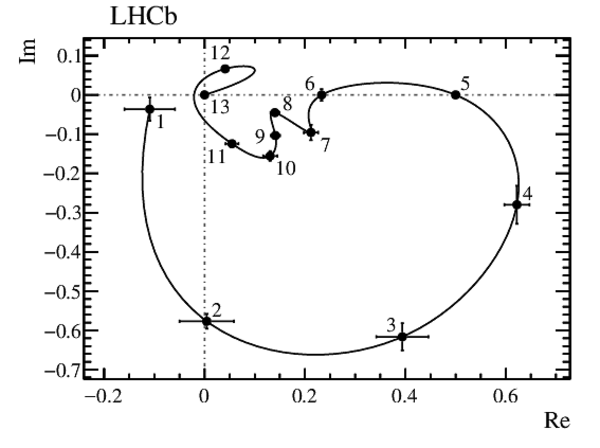
|
|
Differences between the SDP distribution of the data and fit model, in terms of the normalised residual in each bin. No bin lies outside the $z$-axis limits. |
Fig9.pdf [53 KiB] HiDef png [169 KiB] Thumbnail [157 KiB] *.C file |

|
|
Projections of the data and amplitude fit onto (top) $m( D ^+ \pi ^- )_{\rm min}$, (middle) $m( D ^+ \pi ^- )_{\rm max}$ and (bottom) $m(\pi ^- \pi ^- )$, with the same projections shown (right) with a logarithmic $y$-axis scale. Components are described in the legend. |
Fig10a.pdf [57 KiB] HiDef png [232 KiB] Thumbnail [178 KiB] *.C file |

|
|
Fig10b.pdf [57 KiB] HiDef png [373 KiB] Thumbnail [260 KiB] *.C file |
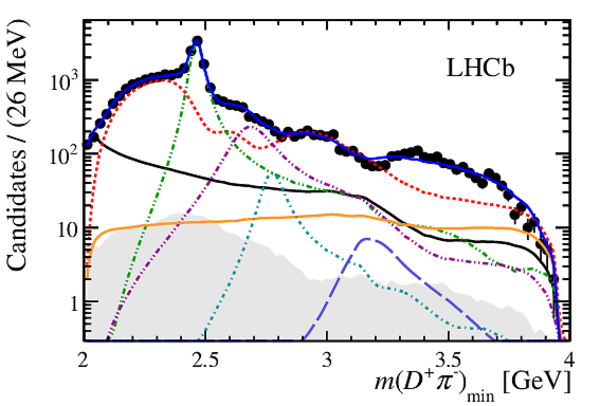
|
|
|
Fig10c.pdf [59 KiB] HiDef png [311 KiB] Thumbnail [216 KiB] *.C file |

|
|
|
Fig10d.pdf [58 KiB] HiDef png [430 KiB] Thumbnail [287 KiB] *.C file |

|
|
|
Fig10e.pdf [56 KiB] HiDef png [280 KiB] Thumbnail [194 KiB] *.C file |

|
|
|
Fig10f.pdf [54 KiB] HiDef png [353 KiB] Thumbnail [241 KiB] *.C file |
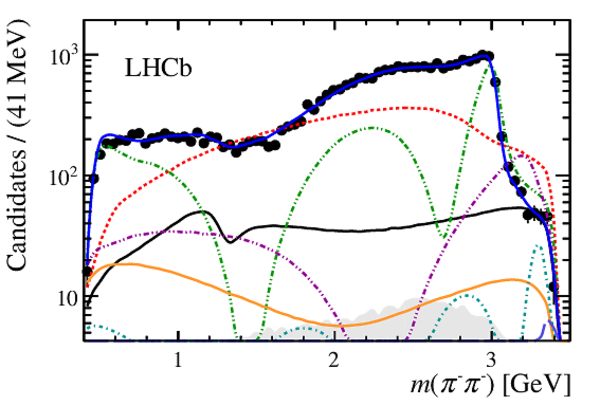
|
|
|
Fig10g.pdf [12 KiB] HiDef png [83 KiB] Thumbnail [68 KiB] *.C file |

|
|
|
Projections of the data and amplitude fit onto (left) $m( D ^+ \pi ^- )$ and (right) the cosine of the helicity angle for the $ D ^+ \pi ^- $ system in (top to bottom) the low mass threshold region, the $ D ^{*}_{2}(2460)^{0}$ region, the $ D ^{*}_{1}(2680)^{0}$ -- $ D ^{*}_{3}(2760)^{0}$ region and the $ D ^{*}_{2}(3000)^{0}$ region. Components are as shown in Fig. 10. |
Fig11a.pdf [52 KiB] HiDef png [206 KiB] Thumbnail [170 KiB] *.C file |
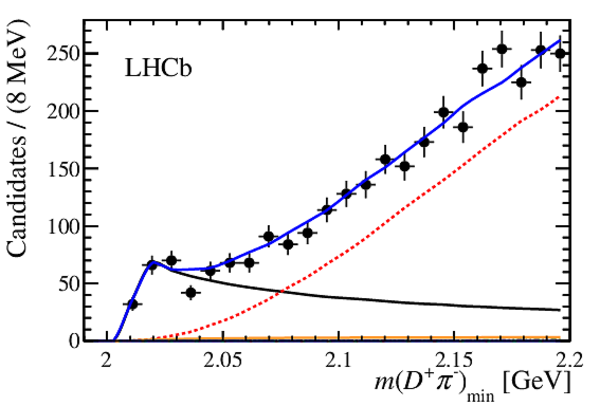
|
|
Fig11b.pdf [66 KiB] HiDef png [217 KiB] Thumbnail [181 KiB] *.C file |

|
|
|
Fig11c.pdf [55 KiB] HiDef png [236 KiB] Thumbnail [189 KiB] *.C file |
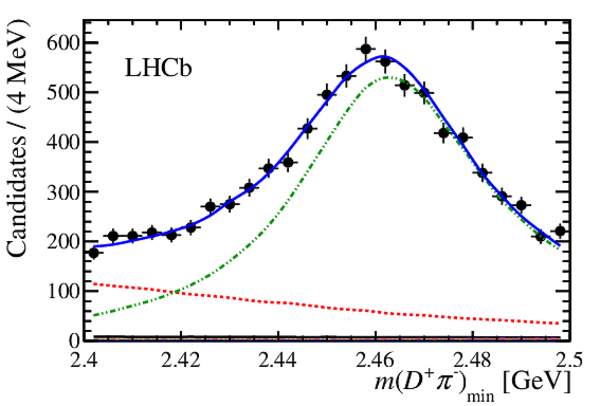
|
|
|
Fig11d.pdf [69 KiB] HiDef png [249 KiB] Thumbnail [191 KiB] *.C file |

|
|
|
Fig11e.pdf [56 KiB] HiDef png [261 KiB] Thumbnail [211 KiB] *.C file |

|
|
|
Fig11f.pdf [71 KiB] HiDef png [329 KiB] Thumbnail [244 KiB] *.C file |

|
|
|
Fig11g.pdf [55 KiB] HiDef png [275 KiB] Thumbnail [202 KiB] *.C file |
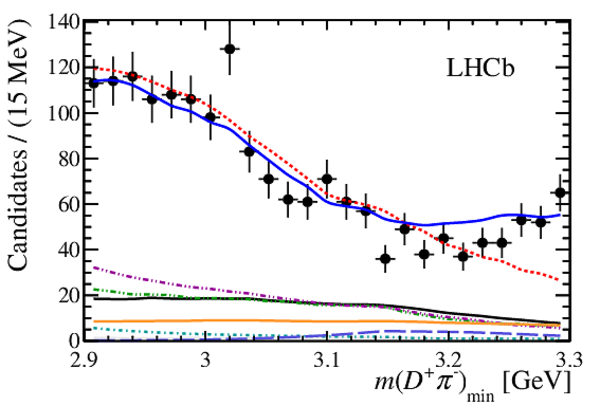
|
|
|
Fig11h.pdf [70 KiB] HiDef png [312 KiB] Thumbnail [220 KiB] *.C file |

|
|
|
Animated gif made out of all figures. |
PAPER-2016-026.gif Thumbnail |

|
Tables and captions
|
Measured properties of neutral excited charm states. World averages are given for the 1P resonances (top part), while all measurements are listed for the heavier states (bottom part). Where two uncertainties are given, the first is statistical and second systematic; where a third is given, it is due to model uncertainty. The uncertainties on the averages for the $ D ^{*}_{0}(2400)^{0}$ mass and the $D_1(2420)^0$ and $ D ^{*}_{2}(2460)^{0}$ masses and widths are inflated by scale factors to account for inconsistencies between measurements. The quoted $ D ^{*}_{2}(2460)^{0}$ averages do not include the recent result from Ref. [12]. |
Table_1.pdf [53 KiB] HiDef png [102 KiB] Thumbnail [50 KiB] tex code |

|
|
Yields of the various components in the fit to $ B ^- \rightarrow D ^+ \pi ^- \pi ^- $ candidate invariant mass distribution. Note that the yields in the signal region are scaled from the full mass range. |
Table_2.pdf [46 KiB] HiDef png [50 KiB] Thumbnail [25 KiB] tex code |

|
|
Signal contributions to the fit model, where parameters and uncertainties are taken from Ref. [19]. States labelled with subscript $v$ are virtual contributions. The model "MIPW" refers to the quasi-model-independent partial wave approach. |
Table_3.pdf [55 KiB] HiDef png [68 KiB] Thumbnail [31 KiB] tex code |

|
|
Masses and widths determined in the fit to data, with statistical uncertainties only. |
Table_4.pdf [44 KiB] HiDef png [83 KiB] Thumbnail [37 KiB] tex code |

|
|
Complex coefficients and fit fractions determined from the Dalitz plot fit. Uncertainties are statistical only. |
Table_5.pdf [56 KiB] HiDef png [80 KiB] Thumbnail [35 KiB] tex code |

|
|
Breakdown of experimental systematic uncertainties on the fit fractions (%) and masses and widths $(\mathrm{Me V} )$. |
Table_6.pdf [62 KiB] HiDef png [137 KiB] Thumbnail [66 KiB] tex code |

|
|
Breakdown of model uncertainties on the fit fractions (%) and masses and widths $(\mathrm{Me V} )$. |
Table_7.pdf [61 KiB] HiDef png [123 KiB] Thumbnail [56 KiB] tex code |

|
|
Results for the complex amplitudes. The three quoted errors are statistical, experimental systematic and model uncertainties. |
Table_8.pdf [55 KiB] HiDef png [174 KiB] Thumbnail [86 KiB] tex code |

|
|
Results for the \DpiS-wave amplitude at the spline knots. The three quoted errors are statistical, experimental systematic and model uncertainties. |
Table_9.pdf [47 KiB] HiDef png [236 KiB] Thumbnail [138 KiB] tex code |

|
|
Results for the fit fractions. The three quoted errors are statistical, experimental systematic and model uncertainties. |
Table_10.pdf [52 KiB] HiDef png [135 KiB] Thumbnail [65 KiB] tex code |

|
|
Results for the product branching fractions ${\cal B}( B ^- \rightarrow R\pi ^- ) \times {\cal B}(R \rightarrow D ^+ \pi ^- )$. The four quoted errors are statistical, experimental systematic, model and inclusive branching fraction uncertainties. |
Table_11.pdf [52 KiB] HiDef png [125 KiB] Thumbnail [63 KiB] tex code |

|
|
Interference fit fractions (%) and statistical uncertainties. The amplitudes are: ($A_0$) $ D ^{*}_{v}(2007)^{0}$ , ($A_1$) \DpiS-wave , ($A_2$) $ D ^{*}_{2}(2460)^{0}$ , ($A_3$) $ D ^{*}_{1}(2680)^{0}$ , ($A_4$) $B^{*0}_v$, ($A_5$) $ D ^{*}_{3}(2760)^{0}$ , ($A_6$) $ D ^{*}_{2}(3000)^{0}$ . The diagonal elements are the same as the conventional fit fractions. |
Table_12.pdf [33 KiB] HiDef png [39 KiB] Thumbnail [19 KiB] tex code |

|
|
(Top) Experimental and (bottom) model systematic uncertainties on the interference fit fractions (%). The amplitudes are: ($A_0$) $ D ^{*}_{v}(2007)^{0}$ , ($A_1$) \DpiS-wave , ($A_2$) $ D ^{*}_{2}(2460)^{0}$ , ($A_3$) $ D ^{*}_{1}(2680)^{0}$ , ($A_4$) $B^{*0}_{v}$, ($A_5$) $ D ^{*}_{3}(2760)^{0}$ , ($A_6$) $ D ^{*}_{2}(3000)^{0}$ . The diagonal elements are the same as the conventional fit fractions. |
Table_13.pdf [27 KiB] HiDef png [48 KiB] Thumbnail [19 KiB] tex code |

|
Created on 02 May 2024.
